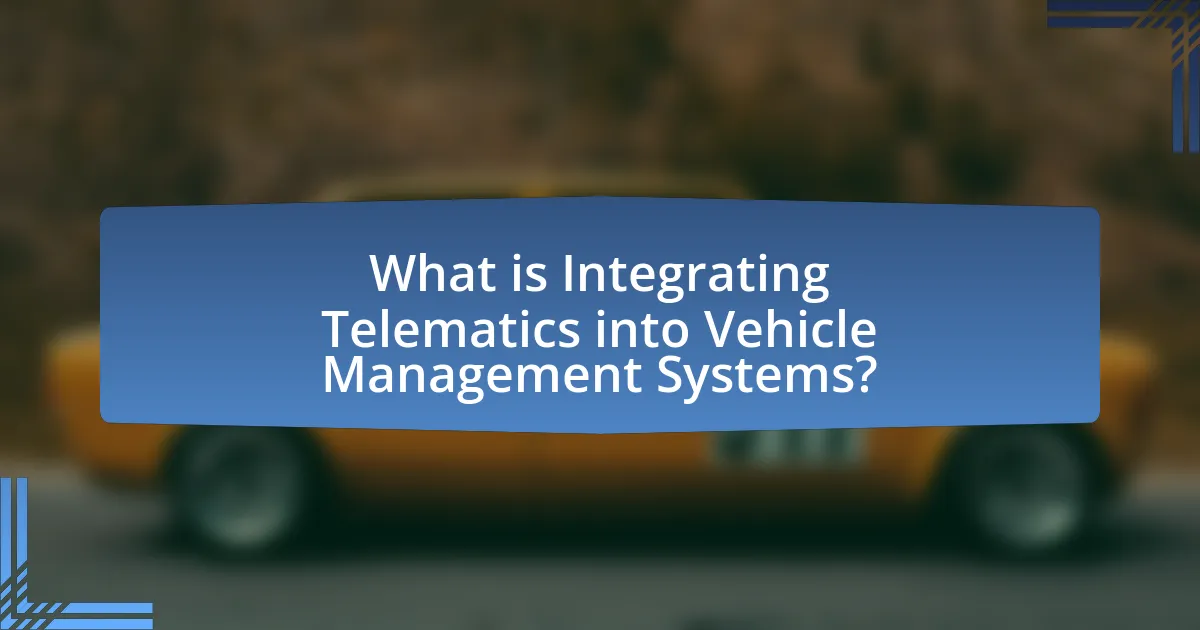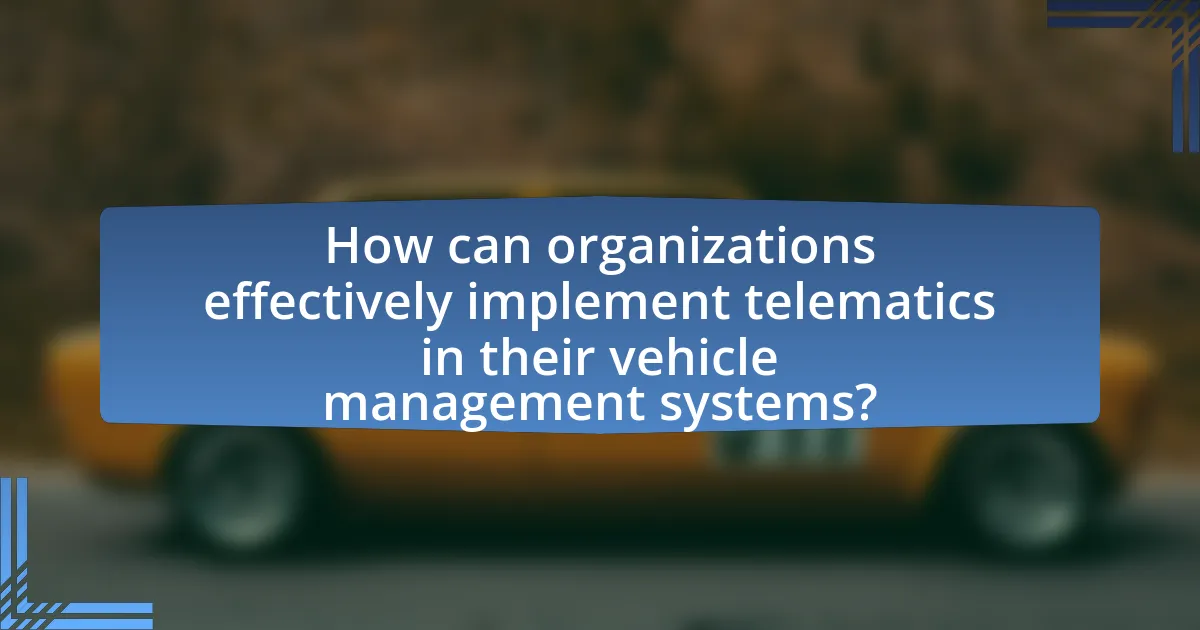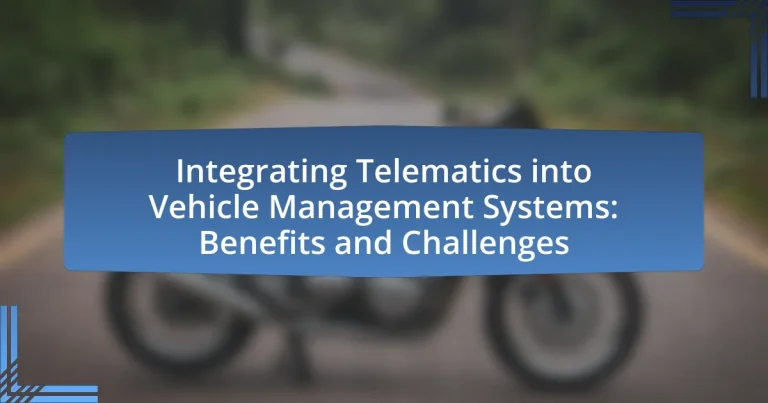Integrating telematics into vehicle management systems involves the use of telecommunications and monitoring technologies to enhance vehicle tracking, diagnostics, and fleet management. This integration provides real-time data on vehicle performance, location, and driver behavior, leading to improved operational efficiency and cost reductions, such as a potential 15% decrease in fuel consumption. Key components of telematics systems include GPS technology, onboard diagnostics, and data processing software, which collectively facilitate effective data transmission and communication. While the benefits of telematics are significant, challenges such as data security, interoperability, and implementation costs must be addressed for successful integration. The article explores these aspects, detailing the operational advantages, safety improvements, and future trends in telematics technology.

What is Integrating Telematics into Vehicle Management Systems?
Integrating telematics into vehicle management systems involves the incorporation of telecommunications and monitoring technologies to enhance vehicle tracking, diagnostics, and overall fleet management. This integration allows for real-time data collection on vehicle performance, location, and driver behavior, which can lead to improved operational efficiency and reduced costs. For instance, a study by the American Transportation Research Institute found that telematics can reduce fuel consumption by up to 15% through better route optimization and driver feedback.
How does telematics technology function within vehicle management systems?
Telematics technology functions within vehicle management systems by integrating GPS, onboard diagnostics, and telecommunications to collect and transmit real-time data about vehicle performance and location. This data enables fleet managers to monitor vehicle health, optimize routes, and improve fuel efficiency. For instance, a study by the American Transportation Research Institute found that telematics can reduce fuel consumption by up to 15% through better route planning and maintenance alerts.
What are the key components of telematics systems?
The key components of telematics systems include GPS technology, onboard diagnostics, telecommunication networks, and data processing software. GPS technology enables real-time location tracking of vehicles, while onboard diagnostics provide vehicle performance data. Telecommunication networks facilitate the transmission of data between vehicles and central systems, and data processing software analyzes this information to generate insights for fleet management. These components work together to enhance vehicle tracking, improve maintenance, and optimize operational efficiency.
How do data transmission and communication work in telematics?
Data transmission and communication in telematics involve the transfer of data between vehicles and remote servers using various communication technologies. Telematics systems utilize GPS for location tracking, onboard diagnostics for vehicle health data, and cellular or satellite networks for data transmission. For instance, a vehicle’s GPS module collects location data, which is then sent via cellular networks to a cloud server, where it can be analyzed and accessed by fleet managers. This process enables real-time monitoring and management of vehicle performance, enhancing operational efficiency and safety.
What are the primary benefits of integrating telematics into vehicle management systems?
Integrating telematics into vehicle management systems primarily enhances operational efficiency, improves safety, and reduces costs. Telematics provides real-time data on vehicle location, speed, and performance, enabling fleet managers to optimize routes and monitor driver behavior. According to a study by the American Transportation Research Institute, fleets that utilize telematics can reduce fuel consumption by up to 15%, demonstrating significant cost savings. Additionally, telematics systems can facilitate proactive maintenance by alerting managers to potential mechanical issues before they lead to breakdowns, further minimizing downtime and repair costs.
How does telematics improve fleet efficiency?
Telematics improves fleet efficiency by providing real-time data on vehicle location, speed, fuel consumption, and driver behavior. This data enables fleet managers to optimize routes, reduce fuel costs, and enhance maintenance schedules. For instance, a study by the American Transportation Research Institute found that fleets using telematics can reduce fuel consumption by up to 15% through better route planning and monitoring of driving habits. Additionally, telematics facilitates proactive maintenance, which can decrease vehicle downtime and extend asset life, further contributing to overall fleet efficiency.
What role does telematics play in enhancing driver safety?
Telematics significantly enhances driver safety by providing real-time data on vehicle performance and driver behavior. This technology enables fleet managers to monitor factors such as speed, braking patterns, and acceleration, allowing for immediate feedback and corrective actions. For instance, a study by the National Highway Traffic Safety Administration found that telematics can reduce crash rates by up to 20% through improved driver training and behavior modification. Additionally, telematics systems can facilitate emergency response by automatically notifying authorities in the event of an accident, further contributing to overall safety on the road.
How can telematics reduce operational costs for businesses?
Telematics can reduce operational costs for businesses by optimizing fleet management and improving vehicle utilization. By providing real-time data on vehicle location, fuel consumption, and driver behavior, telematics enables businesses to identify inefficiencies and implement corrective measures. For instance, a study by the American Transportation Research Institute found that fleet operators using telematics experienced a 10-15% reduction in fuel costs due to better route planning and reduced idling times. Additionally, telematics can lead to lower maintenance costs by facilitating proactive vehicle servicing based on actual usage patterns, thereby extending vehicle lifespan and reducing unexpected breakdowns.
What challenges are associated with integrating telematics into vehicle management systems?
Integrating telematics into vehicle management systems presents several challenges, including data security, interoperability, and cost. Data security concerns arise due to the sensitive nature of the information collected, which can be vulnerable to cyberattacks; a report from the Ponemon Institute indicates that 60% of organizations experienced a data breach in the past year. Interoperability issues occur when different telematics systems and vehicle models do not communicate effectively, leading to inefficiencies; according to a study by Frost & Sullivan, 70% of fleet managers report difficulties in integrating various telematics solutions. Additionally, the cost of implementing and maintaining telematics systems can be prohibitive, with initial setup costs often exceeding $1,000 per vehicle, as noted by the American Transportation Research Institute.
What are the technical challenges faced during integration?
The technical challenges faced during integration of telematics into vehicle management systems include data interoperability, system compatibility, and security vulnerabilities. Data interoperability issues arise when different systems use varying data formats, making it difficult to share and analyze information effectively. System compatibility challenges occur when existing vehicle management systems are not designed to accommodate new telematics technologies, leading to integration difficulties. Security vulnerabilities are a significant concern, as integrating telematics can expose systems to cyber threats, necessitating robust security measures to protect sensitive data. These challenges highlight the complexity of achieving seamless integration in vehicle management systems.
How do data privacy and security concerns impact telematics adoption?
Data privacy and security concerns significantly hinder telematics adoption by creating apprehension among potential users regarding the safety of their data. Organizations fear data breaches and misuse of sensitive information, which can lead to financial losses and reputational damage. For instance, a 2021 survey by the International Data Corporation found that 60% of companies cited data privacy as a major barrier to adopting IoT technologies, including telematics. This apprehension results in slower implementation rates and increased regulatory scrutiny, ultimately stalling the growth of telematics solutions in vehicle management systems.
What are the potential costs involved in implementing telematics solutions?
The potential costs involved in implementing telematics solutions include hardware expenses, software licensing fees, installation costs, and ongoing maintenance and data subscription fees. Hardware costs typically encompass GPS devices, sensors, and onboard diagnostic tools, which can range from a few hundred to several thousand dollars per vehicle depending on the complexity of the system. Software licensing fees may vary based on the provider and the features included, often requiring annual or monthly payments. Installation costs can incur additional charges for professional setup, which may also vary based on the number of vehicles and the specific technology used. Ongoing maintenance and data subscription fees are necessary for continuous access to real-time data and system updates, which can add up to significant annual expenses. According to a study by the American Transportation Research Institute, the total cost of telematics implementation can range from $1,000 to $3,000 per vehicle annually, depending on the scale and scope of the solution.

How can organizations effectively implement telematics in their vehicle management systems?
Organizations can effectively implement telematics in their vehicle management systems by following a structured approach that includes selecting the right technology, integrating it with existing systems, and training personnel. First, organizations should choose telematics solutions that align with their specific operational needs, such as GPS tracking, fuel management, and driver behavior monitoring. For example, a study by the American Transportation Research Institute found that companies using telematics saw a 10-15% reduction in fuel costs.
Next, seamless integration with existing fleet management software is crucial to ensure data consistency and usability. This can involve APIs or middleware that facilitate communication between systems. According to a report from Frost & Sullivan, organizations that successfully integrate telematics with their fleet management systems can improve operational efficiency by up to 20%.
Finally, training staff on how to utilize telematics data effectively is essential for maximizing the benefits. Research from the National Institute for Occupational Safety and Health indicates that organizations that invest in employee training see a significant increase in productivity and safety outcomes. By focusing on these key areas, organizations can successfully implement telematics in their vehicle management systems.
What steps should be taken for successful telematics integration?
Successful telematics integration requires a structured approach that includes several key steps. First, organizations must define clear objectives for the telematics system, such as improving fleet efficiency or enhancing driver safety. Next, selecting the right technology and service providers is crucial; this includes evaluating hardware, software, and connectivity options that align with the defined objectives.
Following technology selection, organizations should ensure proper data management practices are in place, including data collection, storage, and analysis methods to derive actionable insights. Training staff on the new system is essential to maximize its benefits, as well as establishing protocols for ongoing maintenance and support.
Finally, continuous evaluation and optimization of the telematics system are necessary to adapt to changing needs and technologies. According to a study by Frost & Sullivan, companies that implement structured telematics strategies can achieve up to a 15% reduction in operational costs, highlighting the importance of a systematic approach to integration.
How can organizations assess their telematics needs?
Organizations can assess their telematics needs by conducting a comprehensive analysis of their operational requirements, vehicle types, and specific use cases. This involves identifying key performance indicators (KPIs) that align with their business objectives, such as fuel efficiency, driver safety, and maintenance scheduling.
Additionally, organizations should evaluate existing data management systems and determine the integration capabilities of potential telematics solutions. A study by the American Transportation Research Institute highlights that 70% of fleets that implemented telematics reported improved operational efficiency, underscoring the importance of aligning telematics solutions with organizational goals.
What factors should be considered when selecting a telematics provider?
When selecting a telematics provider, key factors include data accuracy, integration capabilities, customer support, and cost-effectiveness. Data accuracy ensures reliable insights for decision-making, while integration capabilities allow seamless connectivity with existing vehicle management systems. Strong customer support is crucial for troubleshooting and maximizing the use of telematics solutions. Cost-effectiveness involves evaluating the total cost of ownership, including hardware, software, and ongoing service fees, to ensure the investment aligns with budget constraints and expected ROI.
What best practices can enhance the effectiveness of telematics in vehicle management?
Implementing real-time data analytics is a best practice that significantly enhances the effectiveness of telematics in vehicle management. By utilizing real-time data, fleet managers can monitor vehicle performance, driver behavior, and maintenance needs instantly, leading to improved decision-making. For instance, a study by the American Transportation Research Institute found that fleets using telematics data for real-time monitoring experienced a 10-15% reduction in fuel costs and a 20% decrease in maintenance expenses. Additionally, integrating telematics with route optimization software can further improve efficiency by reducing travel time and fuel consumption, as evidenced by a report from the European Commission, which highlighted that optimized routing can save fleets up to 30% in operational costs.
How can organizations ensure data accuracy and reliability?
Organizations can ensure data accuracy and reliability by implementing robust data validation processes and regular audits. These practices involve cross-referencing data against established benchmarks and conducting systematic checks to identify discrepancies. For instance, a study by the Data Management Association found that organizations that regularly audit their data can reduce errors by up to 30%. Additionally, utilizing automated data collection tools, such as telematics systems, enhances accuracy by minimizing human error and providing real-time data updates. This combination of validation, auditing, and automation creates a comprehensive framework for maintaining high data quality in vehicle management systems.
What training is necessary for staff to utilize telematics effectively?
Staff requires comprehensive training in telematics systems, data interpretation, and software usage to utilize telematics effectively. This training should include hands-on experience with telematics devices, understanding data analytics, and learning how to interpret real-time data for decision-making. Additionally, training should cover compliance with regulations and best practices in data privacy and security. Research indicates that organizations that invest in targeted telematics training see a 20% increase in operational efficiency, demonstrating the importance of proper training in maximizing the benefits of telematics.

What future trends can be expected in telematics and vehicle management systems?
Future trends in telematics and vehicle management systems include increased integration of artificial intelligence for predictive analytics, enhanced connectivity through 5G technology, and a greater focus on sustainability through electric vehicle (EV) management. The integration of AI allows for real-time data analysis, improving decision-making and operational efficiency. The rollout of 5G enhances data transmission speeds, enabling more reliable communication between vehicles and infrastructure. Additionally, as the automotive industry shifts towards electrification, telematics systems will increasingly support the management of EV fleets, optimizing charging and maintenance schedules. These trends are supported by industry reports indicating a projected growth in the telematics market, expected to reach $75 billion by 2025, driven by advancements in technology and increasing demand for fleet efficiency.
How is technology evolving in the telematics space?
Technology in the telematics space is evolving through advancements in connectivity, data analytics, and artificial intelligence. Enhanced connectivity, driven by 5G networks, allows for real-time data transmission from vehicles to cloud-based systems, improving communication and responsiveness. Data analytics tools are becoming more sophisticated, enabling the processing of vast amounts of data collected from vehicles, which helps in predictive maintenance and optimizing fleet management. Additionally, artificial intelligence is being integrated to analyze driving patterns and improve safety features, leading to smarter vehicle management systems. These advancements are supported by industry reports indicating that the global telematics market is projected to grow significantly, reaching approximately $100 billion by 2025, highlighting the increasing reliance on technology in this field.
What advancements in data analytics are influencing telematics?
Advancements in data analytics influencing telematics include real-time data processing, machine learning algorithms, and predictive analytics. Real-time data processing enables immediate insights from vehicle data, enhancing decision-making and operational efficiency. Machine learning algorithms analyze vast datasets to identify patterns and optimize vehicle performance, leading to improved maintenance schedules and reduced downtime. Predictive analytics forecasts potential issues before they arise, allowing for proactive measures that enhance safety and reduce costs. These advancements are supported by the increasing availability of big data and cloud computing, which facilitate the storage and analysis of complex telematics data.
How might autonomous vehicles impact telematics integration?
Autonomous vehicles will significantly enhance telematics integration by enabling real-time data collection and analysis for improved vehicle management. These vehicles are equipped with advanced sensors and communication systems that continuously gather data on performance, location, and environmental conditions. This capability allows for more accurate monitoring and predictive maintenance, reducing downtime and operational costs. For instance, a study by McKinsey & Company indicates that the integration of telematics in autonomous vehicles can lead to a 20-30% reduction in maintenance costs due to proactive diagnostics and timely interventions. Thus, the impact of autonomous vehicles on telematics integration is profound, driving efficiency and reliability in vehicle management systems.
What practical tips can organizations follow to maximize telematics benefits?
Organizations can maximize telematics benefits by implementing a comprehensive data analysis strategy. This involves regularly analyzing telematics data to identify patterns in vehicle usage, fuel consumption, and maintenance needs, which can lead to improved operational efficiency. For instance, a study by the American Transportation Research Institute found that optimizing routes based on telematics data can reduce fuel costs by up to 10%. Additionally, organizations should ensure that all employees are trained to use telematics systems effectively, as proper usage can enhance data accuracy and decision-making. Regularly updating telematics technology and integrating it with existing vehicle management systems can also enhance functionality and provide real-time insights, further maximizing the benefits.
How can regular system updates improve telematics performance?
Regular system updates enhance telematics performance by ensuring that software is optimized for the latest hardware and network capabilities. These updates often include bug fixes, security patches, and performance improvements that directly affect data accuracy and transmission efficiency. For instance, a study by the International Telecommunication Union found that timely software updates can reduce system downtime by up to 30%, thereby improving the reliability of telematics data. Additionally, updates can introduce new features that enhance data analytics, allowing for better decision-making in vehicle management.
What strategies can be employed to foster user engagement with telematics systems?
To foster user engagement with telematics systems, companies can implement personalized user interfaces and gamification techniques. Personalized interfaces enhance user experience by tailoring information and features to individual preferences, which has been shown to increase user satisfaction and retention. Gamification, such as incorporating rewards for safe driving or efficient vehicle usage, can motivate users to interact more frequently with the system. Research indicates that gamification can lead to a 30% increase in user engagement levels, demonstrating its effectiveness in maintaining user interest and participation in telematics systems.


